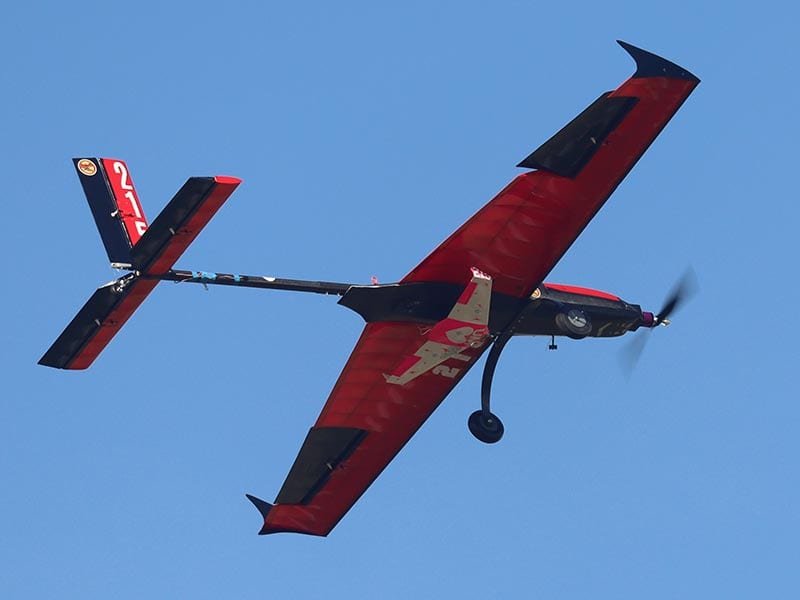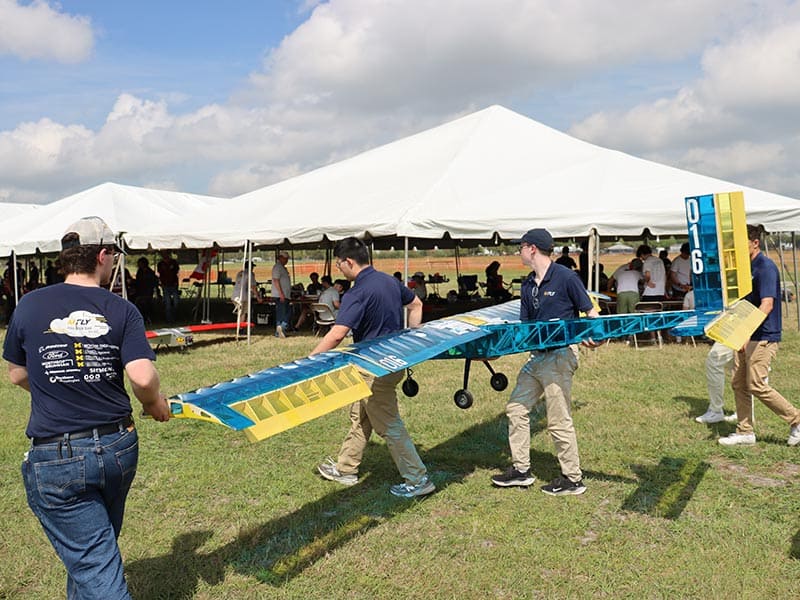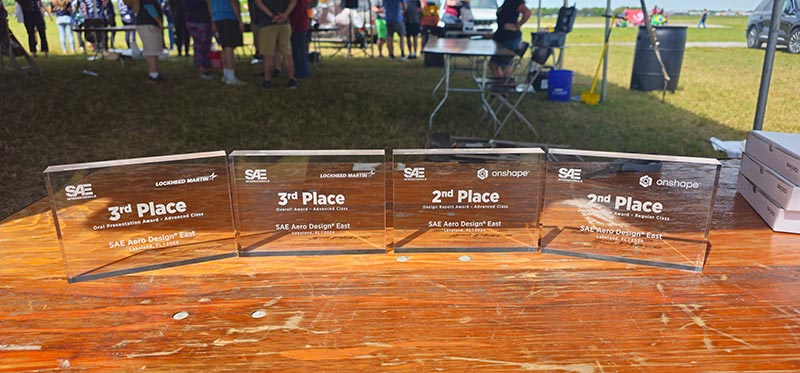
M-Fly Secures Second and Third Place Wins at the Annual SAE competition
Student organization celebrates as they eagerly anticipate the Student Unmanned Aerial Systems (SUAS) Competition in June

Student organization celebrates as they eagerly anticipate the Student Unmanned Aerial Systems (SUAS) Competition in June
Building, testing and flying planes, what more could an aviation student dream of? This year, on March 8, our M-Fly student organization put their expertise and creativity to the test at the annual SAE Aero Design East Challenge at Paradise Field in Lakeland, Florida.
The team is proud to announce their hard work and dedication paid off as they took home awards in various categories and are eagerly anticipating their next event in June of 2024 at the Student Unmanned Aerial Systems (SUAS) Competition, where they will be attending for the first time. Throughout the past year, they have been working together to construct three planes, two for the SAE challenge and one for the SUAS competition. Building off of the knowledge they have gained from their SAE challenge in March, they are continuing to test and make adjustments to their third aircraft in order to be ready for the SUAS competition where they will show off their autonomous, unmanned aerial systems aircraft.
The SAE Competition:
The SAE competition is a tri-annual competition, making significant changes implemented to their rules and regulations every three years. Minor adjustments are made annually within this timeframe, allowing the team to have an expectation of what the competition will consist of each year.
“The three year cycle for the advanced class competition just concluded so this was the last year with this set of rules, next year there will be totally different rules that we will have to work with. The regular class competition also changes every three years, but on a different cycle. That cycle just changed last year which means this year is the second year,” explained M-Fly team captain, Daniel Efunwa. “That’s also the fun part of it, because who knows what it will be like next year, it’s always very interesting.”
The M-Fly team competes in two of the three divisions at the SAEs: Advanced Class and Regular Class, or Hi-Lift as they refer to it. Rules are unveiled in mid-September, providing them approximately six months to develop, test and prepare for competition. The Advanced Class and Regular Class competitions each consist of three scoring opportunities, the design report, flight demonstration readiness review (FDRR) and an in-flight mission performance.
Each of the teams’ aircrafts has a different subteam responsible for overseeing the development of each. For the Advanced Class competition this year, their MX-9 aircraft consisted of a main aircraft which had to fly stable, drop a Powered Autonomous Delivery Aircraft (PADA) and land on a target for the team to get points. Meanwhile, the Regular Class aircraft, the M-16, had to carry weight in the form of steel plates with restrictions made on the aircrafts design, such as a 750-watt power limit, creating a challenge for the aircraft to support the heavy payload.

The M-Fly Team & Aircrafts:
After last year’s competition, the team set out to make big changes towards being successful in this year’s event. One of the changes they made was aimed toward their design process and design philosophy. They decided that by starting the process significantly earlier, they would have a leg up on previous years, and on their competition at the event.
Over the summer, the team went to work. They started by designing the Outer Mold Layer (OML) and selected the motor and propeller combination for the aircrafts. This process helps determine the thrust they would get on the aircraft and how much payload weight it can carry.
Team captain Efunwa further explained that once the fall semester started they really got to work on the designs and details of the competition. The rules could change up until mid-September, which would make the work we had been doing “somewhat useless” even if there were minor changes to the rules. However, this year they took a bold step and encouraged each other to begin the design cycles earlier, allowing them as much time to test fly as possible.
The team successfully did this by getting their advisor and alumni involved with their Initial Design Review (IDR), where the leadership team had sketches to review and provide feedback on. The team was then able to dive into the school year with their OML, motor and propeller configurations already selected.
“Since the rules change every three years, there was really no reason for us to not start working on it [the design cycle]. We figured that even if all the work and design is rendered useless by the tiniest of changes in the rules, going through that whole initial design process is a really good learning experience. That way the next time we do it, with the members we recruit during the fall semester, it’s a lot smoother of a process and we better understand how everything should flow and can even do it better and faster the second time around,” Efunwa stated.
When the rules of the competition did not change drastically, the team felt they had luck on their side, as the only alteration they had to make was towards the Regular Class aircraft’s maximum wing span, which decreased from 18 feet to 15 feet. The team quickly overcame this obstacle by making minor configuration changes, decreasing their initial wingspan of 15.5 feet to the required 15 feet maximum for the competition.
Thanks to all of their work over the summer and in the early months of fall, the team was able to start their additional design reviews, the Preliminary Design Review (PDR) and Critical Design Review (CDR), earlier than previous years, giving them the ability to start their manufacturing and building season in December. After unveiling their planes on February 7, the team flew their two SAE planes and their autonomous aircraft for the SUAS Competition by February 10.
Efunwa commented, “The one fundamental key to success in this competition, and to engineering in general, is the ability to test your design, and test and test. We wanted to give ourselves the ability to test fly as much as possible, especially with the Advanced Class aircraft which is more of a systems based competition. So there are a lot of complex systems working and you need to test every single one of them individually and together to ensure success.”
The team ran into multiple strings of bad weather while trying to test their aircrafts, hindering them from test flying in various instances. “We just got extremely unlucky with the February weather. Unfortunately, we weren’t really able to test fly as much as we wanted to but we were able to sneak in a few days here and there during the weekdays.”
The Sunday before the team made their trip down to the competition in Florida, they gathered at their testing location, the MRCA RC Model Aircraft Field in Milan, Michigan, and got to work on last minute test flights. Later that week they traveled down to Florida, arriving a day before the competition began and allowing them the opportunity to test fly the day before.

Post Competition Results:
Throughout the competition, the team experienced great success while also overcoming various setbacks related to their aircrafts. “There were a few issues that came up during the competition. Sometimes there is an issue that comes up during competition that will only come up during competition. You just never know until you get there, but I think that if we would have had a few more test flights we maybe would have caught them,” commented Efunwa.
In addition to the bad weather, the team also experienced issues with the advanced aircraft and the deployment of their PADA during the competition. “Our working theory that we are trying to solve, was given that we were so close to an active airport during the test flying, one of the systems and connection with the ground station and the PADA just didn’t work as well and was getting disrupted,” explained Efunwa. “After the fact, we realized there were some equipment and some tools that some team members wanted to purchase, and there was just some miscommunication with getting that purchased and getting it sorted out ahead of time.”
For the Regular Class aircraft, the team ran into problems with the wind while at the competition. During their first attempted take off, the plane was knocked to the side by the wind and a piece of the nose gear broke off.

Due to this unexpected setback, the team used the two days of the competition to get a secondary mechanism working with what they had on hand, rushing to get the flight in. “Unfortunately, when we were able to take off, the aircraft did its lap and landed, but on the landing the fabricated piece that we had seemed to snap off, causing it to turn off the runway. According to the rules, if the landing gear turns off the runway then that flight does not count.”
Through the various issues the team faced, they made sure to highlight areas where they were successful. Efunwa highlighted the importance of technology communication being a strength they had, due to the various members on the team who excel in that area.
“We really questioned and analyzed everything, for example our design report, we wrote it super early but we didn’t stop there. We had each of our teams read each other’s reports and our professor from Aero 405, Graduate/PhD students, and alumni read it. We tried not to create an environment where we were in an echo chamber. We also worked really closely with MACH, one of the other student organizations associated with Michigan Aerospace, and by removing that echo chamber we weren’t self validating our results,” explained Efunwa.
Thanks to their thorough efforts in getting different perspectives and the community they had developed within the Michigan Aerospace Department, they were provided the ability to see different options going forward in their design process.
The M-Fly student organization was proud to announce that they were able to bring home multiple trophies to show for their hard work and dedication. In the Advanced Class competition, the team brought home second place in their design report, third place in their readiness review presentation and third place overall in the competition. Meanwhile they also brought home second place in the Regular Class design report.

“I feel like we did everything as close to the best that we could, things still happened but I think we will just have to be more aware of that in the future. Progress is still progress and we won three additional awards this year than we won last year.”
As the team prepares for the SUAS competition in June, they are using what they learned from the SAE’s as leverage, bettering their autonomous aircraft as they go and finding new ways to test fly their projects. The team has been working to qualify for the competition for the past few years. “We are very confident, but we have had a few issues come up recently that we are working through.” The M-Fly team is hopeful that they can make their attendance at the June competition more consistent moving forward.